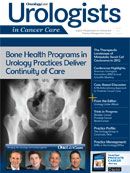Marital Status Impacts Survival in Prostate Cancer Patients
Marital status is an independent predictor of disease-related mortality and overall mortality in men with prostate cancer.
Mark D. Tyson, MD
Marital status is an independent predictor of disease-related mortality and overall mortality in men with prostate cancer, according to data released at the American Urological Association 2012 Annual Scientific Meeting held May 19-23 in Atlanta, Georgia.
Mark D. Tyson, MD, a urology resident at the Mayo Clinic in Phoenix, Arizona, and colleagues examined the impact of marriage on survival outcome in 115,922 men whose prostate cancer had been reported to the Surveillance, Epidemiology, and End Results (SEER) registry between 1988 and 2003. The SEER database covers 17 representative geographic regions within the United States, which encompass approximately 25% of the general population.
While prior research using SEER data from 1973 to 1990, as well as a study in a Norwegian birth cohort from 1960 to 1991, had shown similar favorable effects of marriage on prostate cancer, there have been no data exploring the impact of marriage in a contemporary cohort of patients with prostate cancer.
Being married has also been shown to boost survival in men with bladder and testicular cancer.
Overall, 78% of men included in the analysis were married and 22% were unmarried. The unmarried category included men who were single, separated, divorced, or widowed.
After controlling for age, American Joint Committee on Cancer stage, tumor grade, and race, unmarried men had a 40% increase in the relative risk of prostate cancer-specific mortality (hazard ratio [HR] = 1.40; 95% CI, 1.35-1.44; P < .0001) and a 51% increase in overall mortality (HR = 1.50; 95% CI, 1.48-1.54; P < .0001). Furthermore, the 5-year disease-specific survival rates were 89.1% and 80.5% for married men and unmarried men, respectively (P < .0001).
Tyson suggested that the lower mortality rate in married men may be secondary to stronger social support. “Marriage is one of the most important types of social support and has been linked to favorable biologic profiles with beneficial changes in cardiovascular, neuroendocrine, and immune function,” he said.
Married men have also been shown to adhere to treatment more than unmarried men.
On the other hand, “lead-time bias” may have contributed to the observed survival advantage since married patients are more likely to be diagnosed at earlier clinical stages.
Tyson cautioned that the study may be limited by selection bias, in that those who live longer “simply have more time to get married.” In addition, the study had a retrospective design, and is therefore susceptible to limitations typical of observational data such as quality and completeness of data reporting.
Tyson M, Andrews P, Etzioni D, et al. Marital status and prostate cancer outcomes. Presented at the American Urological Association Annual Meeting; May 19-23, 2012; Atlanta, GA. Abstract 171.




